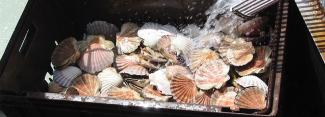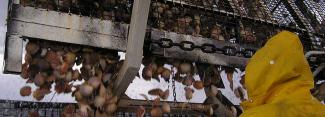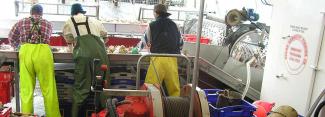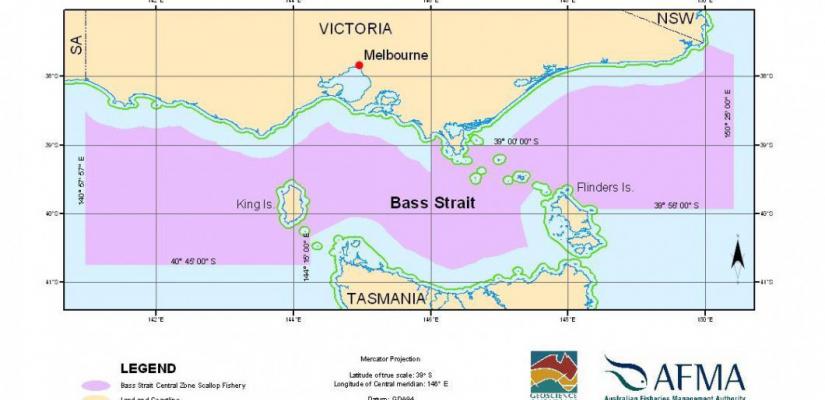ScallopRAG and ScallopMAC met on 19 and 20 June, respectively, to consider the outcomes of the 2025 pre-season biomass survey for the Bass Strait Central Zone Scallop Fishery (BSCZSF) and provide advice to the AFMA Commission on the total allowable catches (TACs), closures and season dates for the BSCZSF 2025 fishing season.
The information provided below does not represent the view of the AFMA Commission. The Commission considers advice from the committees in coming to a resolution on the settings for each fishing season.




Target Species
| Species | Fishing Mortality* | Biomass** |
|---|---|---|
Pecten fumatus | G;Not subject to overfishing | G;Not overfished |
* Fishing mortality status relates to the level of fishing pressure on a stock - specifically, whether fishing mortality in the year being assessed is likely to result in the stock becoming overfished, or prevent the stock from rebuilding from an overfished state. If fishing mortality exceeds either of these thresholds, a stock is considered to be subject to overfishing.
** Biomass status relates to how many fish there are - specifically, whether the biomass in the year being assessed is above the level at which the risk to the stock is considered to be unacceptable. The HSP defines this level as the limit reference point, below which the stock is considered to be overfished.
Catch allowance
| Species | 2025 TAC (tonnes) | 2024 TAC actual catch (tonnes) | 2024 TAC (tonnes) | 2023 TAC actual catch (tonnes) | 2023 TAC (tonnes) | 2022 TAC actual catch (tonnes) | 2022 TAC (tonnes) (tonnes) | 2021 TAC actual catch (tonnes) | 2021 TAC (tonnes) | 2020 TAC actual catch (tonnes) | 2020 TAC (tonnes) |
|---|---|---|---|---|---|---|---|---|---|---|---|
| Commercial scallop | 3841 | 1015 | 3887 | 1984 | 3862 | 432 | 3905 | 2344 | 3905 | 2732 | 3000 |
| Doughboy scallop | 100 | 0 | 100 | 0 | 100 | 0 | 100 | 0 | 100 | 0 | 100 |
Download data on annual catch and effort from AFMA logbooks.
Total fishery value
$A 2.8 million (2015)
Fishing gear
Fishers use towed dredges. The dredge used in the fishery is constructed of a heavy steel frame covered with steel mesh but open on the front side which is towed and is used to lift scallops out of the sand and mud.
Read more about towed dredges.
Location
This fishery operates in the Bass Strait above Tasmania and extends from the Victoria/New South Wales border, around southern Australia to the Victoria/South Australia border. The fishery is between the Victorian and Tasmanian scallop fisheries that lie within 20 nm of their respective coasts.
Major landing ports
- San Remo (Victoria)
- Queenscliff (Victoria)
- Stanley (Tasmania)
- Devonport (Tasmania)
Markets supplied
- Fresh product – Domestic
In previous years some product has been exported, however, regular export markets do not currently exist.
Commercial fishers are able to target doughboy scallop, a species common throughout Bass Strait that is rarely retained as markets for the species do not currently exist.
Fishing season
The fishing season is a period determined by AFMA, typically July to 31 December.
Management of catch
Management of the Bass Strait Central Zone Scallop Fishery involves both input (effort) and output (catch) controls. These include seasonal and spatial closures and catch limits for both species of scallops.
The total allowable catch limit is distributed as quota allocations between concession holders in the fishery and these quota allocations can be transferred temporarily during the season or permanently to other concession holders.
There is high variability in abundance, growth, mortality, meat yield and condition of commercial scallops in the fishery. This variability means that management of commercial scallops has to be adaptable to sometimes rapidly changing circumstances. The stock recruitment relationship is sporadic and intermittent. Growth rates are variable within the fishery, with scallops growing at different rates in different areas.
The fishery is also managed through the Bass Strait Central Zone Fishery Harvest Strategy which uses a tiered approach designed to apply different levels of management and research depending on the state of the resource.
Licence to fish
Fishers need to hold statutory fishing rights allocated by AFMA to fish in the Bass Strait Central Zone Scallop Fishery.
Each season a statutory fishing right will hold a different kilogram value depending on the total allowable catch set in the fishery. Each operator is limited to catching the amount of quota in kilograms determined by the number of statutory fishing rights.
Statutory fishing rights allow fishers to catch the fish species that are under a quota. Statutory fishing rights are transferable between fishers.
In this fishery there are currently:
- 444 500 commercial scallop quota statutory fishing rights
- 455 000 doughboy scallop quota statutory fishing rights
Number of active boats
- 10 active boats
Collecting data
Data about the catch and effort of the fishery is collected from the logbooks fishers fill out for every fishing shot.
Logbooks record:
- the species and amount caught
- catch that is discarded
- the catch/release of any protected species and their life status
- set and haul times of each shot
- the location of each shot
- the type and amount of gear used
- interaction with wildlife and protected species.
Species sustainability
Australia (ABARES 2020):
- Commercial scallop – not subject to overfishing and not overfished
Species risk assessments
AFMA regularly monitor the effects fishing activities have on marine species, habitats and communities through ecological risk assessments. The assessment results help to prioritise the management, research, data collection and monitoring needs for the fishery.
After the risk assessment is complete, an ecological risk management strategy is developed to address how AFMA will manage marine species, habitats and communities identified in the assessment as greatly impacted by commercial fishing operations.
Go to the assessment and strategy for the Bass Strait Central Zone Scallop Fishery.
Bycatch work plans
Bycatch in the Bass Strait Central Zone Scallop Fishery has been low primarily because of the targeted nature of fishing.
The Bass Strait Central Zone Scallop Fishery Bycatch and Discard Workplan outlines ways to minimise the bycatch of species that are at a high risk of being caught as bycatch in the fishery. The plan focuses on discards or damaging interactions with fishing gear of juvenile or damaged commercial scallops, doughboy scallops, threatened, endangered and protected species and other non-targeted fish species.
Find the Bass Strait Central Zone Scallop Fishery Bycatch and Discard Workplan under Fishery Publications.
Harvest strategy
A harvest strategy is used to help determine what the quota should be for the target species of the fishery. Fishing, environmental and economic information is included in the harvest strategy, which helps to monitor and maintain the sustainability of the targeted species.
All harvest strategies are developed in line with the Commonwealth Fisheries Harvest Strategy Policy and Guidelines.
Go to the Bass Strait Central Zone Scallop Fishery Harvest Strategy.
Export approval
To export from an Australian commercial fishery, the fishery must be accredited by The Department of the Environment, through the Environment Protection and Biodiversity Conservation Act 1999 (EPBC Act).
Conditions and recommendations that must be adhered to through the most recent accreditation can be found on the Department of the Environment website.
Marine reserves
Commonwealth marine reserves are areas established under Australian environment law to help us conserve the spectacular marine life in our oceans. They allow ecologically sustainable use of our marine resources and provide special places for people to enjoy and appreciate the fantastic diversity of our marine habitats.
Marine reserves are sometimes known as marine protected areas or marine parks and are managed by the Department of the Environment.
More information about marine reserves can be found on the Department of the Environment website.
Fishing in the fishery
Fishing operators wanting to fish in the fishery must hold quota statutory fishing rights for all target species in the fishery.
Download a copy of the latest Bass Strait Central Zone Scallop Fishery Management Arrangements Booklet for a full description of all fishing requirements in the fishery.
Fishery legislation
- Bass Strait Central Zone Scallop Fishery (Total Allowable Catch) Determination 2023
- Bass Strait Central Zone Scallop Fishery (Fishing Season) Determination 2023
- Fisheries Management (Bass Strait Central Zone Scallop Fishery) (Closures) Direction 2023
Management plan
Harvest strategy
The objectives of the Bass Strait Central Zone Scallop Fishery Harvest Strategy are to keep stocks within the fishery at ecologically sustainable levels and, within that context, maximise the economic returns to the Australian community, and to pursue efficient and cost-effective management.
We recognise that fisheries management involves a broad range of stakeholders.
Here are just a few ways we are working with our stakeholders, who include industry, scientists, environmental groups and the community for an informed approach to fisheries management.
Fishing industry
Each fishing season, AFMA officers discuss current trends in fishing and catches with industry members on advisory groups and with operators in port. All this information is useful for the continuing management of the fishery.
Scallop Management Advisory Committee
The Scallop Management Advisory Committee is the advisory body for the Bass Strait Central Zone Scallop Fishery. The committee includes representatives from AFMA, scientific agencies, environmental non-government organisations and state government.
See the Scallop Management Advisory Committee webpage for a summary of the latest discussions and outcomes from the committee.
Scallop Resource Assessment Group
The Scallop Resource Assessment Group provides research and scientific advice for the Bass Strait Central Zone Scallop Fishery. The group is composed of fishery scientists, fishery industry members, an economist, an AFMA representative, and an environmental non-government organisation representative.
See the Scallop Resource Assessment Group webpage for a summary of the latest discussions and outcomes from the group.
Government departments
AFMA works closely with other government departments, such as the Department of Agriculture and Water Resources and the Department of the Environment. They help in providing advice and guidance on both domestic and international fisheries issues.
State governments
The fishery lies between the Victorian and Tasmanian scallop fisheries within 20nm of their respective coasts.
Representatives from the state fisheries agencies attend the Scallop Management Advisory Committee and Scallop Resource Assessment Group meetings and provide input and advice.
Environmental non-government organisations
Representatives from environmental non-government organisations are engaged through several forums to provide advice on research and management issues in the Bass Strait Central Zone Scallop Fishery.
- AFMA holds 2 to 3 environmental forums annually.
- There are representatives on the Scallop Management Advisory Committee and Scallop Resource Assessment Group.
Management publications
- Bass Strait Central Zone Scallop Fishery Harvest Strategy
- Bass Strait Central Zone Scallop Fishery Management Arrangements Booklet
- Bass Strait Central Zone Scallop Fishery Management Plan 2002
Environmental publications
- Bass Strait Central Zone Scallop Fishery Bycatch and Discard Workplan 2025
- Ecological Risk Assessment for Effects of Fishing Report for the Bass Strait Central Zone Scallop Sub-Fishery
- Residual Risk Assessment for the Bass Strait Central Zone Scallop Fishery
- Ecological Risk Management Report for the Bass Strait Central Zone Scallop Fishery
Annual survey reports
- 2025 BSCZSF Survey Report (PDF, 8.51 MB)
- 2024 BSCZSF Survey Report (PDF, 4.43 MB)
- 2023 BSCZSF Survey Report (PDF, 4.47 MB)
- 2022 BSCZSF Survey Report (PDF, 3.21 MB)
- 2021 BSCZSF Survey Report (PDF, 3.49 MB)
- 2019 BSCZSF Survey Report (PDF, 3.1 MB)
- 2018 BSCZSF Survey Report (PDF, 2.74 MB)
- 2017 BSCZSF Survey Report (PDF, 3.26 MB)
- 2016 BSCZSF Survey Report (PDF, 2.77 MB)
- 2015 BSCZSF Survey Report (PDF, 1.42 MB)
- 2013 (August) BSCZSF Survey Report (PDF, 337 KB)
- 2013 (June) BSCZSF Survey Report (PDF, 509 KB)
- 2012 BSCZSF Survey Report (PDF, 994 KB)
- 2011 BSCZSF Survey Report (PDF, 400 KB)
- 2010 BSCZSF Survey Report (PDF, 720 KB)
- 2009 BSCZSF Survey Report (PDF, 821 KB)
Research and data publications
- Population biology and bed dynamics (2025) (PDF, 6.25 MB)
- Principles for prioritising survey beds (2021) (PDF, 819 KB)
- Options for improving management of commercial scallop resource in South-East Australia (2011) (PDF, 563 KB)
- Facilitating industry self-management for spatially managed stocks: a scallop case study (2008) (PDF, 4 MB)
- Five-year strategic research plan 2022–26 (PDF, 637 KB)
Map of the Bass Strait Central Zone Scallop Fishery

AFMA uses many methods to monitor the compliance of fishing activities and collect data on fish stocks. These include:
Onboard observers
One of the main monitoring methods used by AFMA is onboard scientific observers. Observers are people employed by AFMA to go out on boats and independently record catch, effort and biological information of each fishing trip.
They take samples from fish, such as the otoliths or ear bones, and these are used later to determine the age of the fish caught.
Observers also record the length, weight and sex of a sample of the fish caught during a trip and report on the other wildlife that may be seen, the weather conditions, the composition of commercial catch fate of species that are caught as bycatch.
Boats in the fishery must carry an AFMA observer when requested by AFMA.
Read more about the Observer program.
Satellite tracking
A satellite monitoring system called a Vessel Monitoring System (VMS) is fitted on all concession holders' boats. This system helps AFMA to monitor vessel position, course and speed. The system regularly transmits the information to a database at AFMA.
Read more about our Satellite vessel tracking and monitoring program.
Cameras on fishing boats – electronic monitoring
AFMA has electronic monitoring systems on some fishing boats. These systems have sensors linked to surveillance cameras that record fishing activity. These recordings can then be collected and monitored by AFMA. Electronic monitoring gives fishers a cost effective way to support monitoring and data collection.
Read more about electronic monitoring of fishing boats.